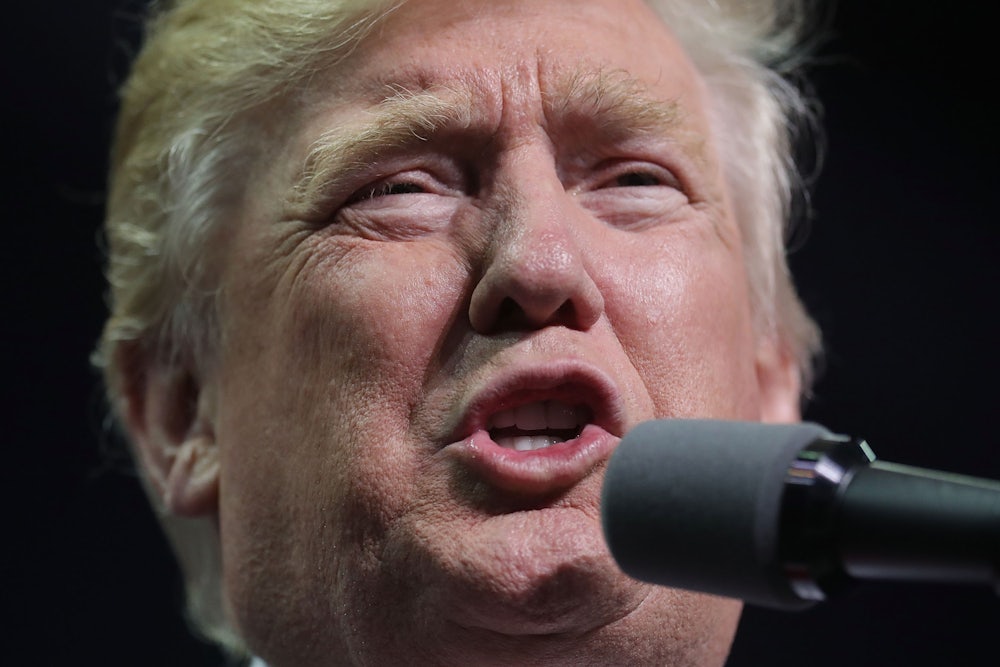Just a few days before the election, President Barack Obama and his political director David Simas got into a heated discussion about the proliferation of “fake news” and the way it might be shaping American politics. According to a profile in The New Yorker, “Obama and Simas talked almost obsessively about an article in BuzzFeed that described how the Macedonian town of Veles had experienced a ‘digital gold rush’ when a small group of young people there published more than a hundred pro-Trump Web sites, with hundreds of thousands of Facebook followers.” These Macedonian sites, done for profit rather than ideological motives—but catering to the American right—featured false stories like the one headlined “Hillary Clinton In 2013: ‘I Would Like To See People Like Donald Trump Run For Office; They’re Honest And Can’t Be Bought,’” and spread the claim that Pope Francis had endorsed Donald Trump.
Buzzfeed followed up that article with a startling analysis: “In the final three months of the U.S. presidential campaign, the top-performing fake election news stories on Facebook generated more engagement than the top stories from major news outlets such as the New York Times, Washington Post, Huffington Post, NBC News, and others.” BuzzFeed’s methodology has been criticized by the Washington Examiner for focusing on too narrow a range of major news outlets. But what BuzzFeed does indisputably show is that false stories with a pro-Trump, anti-Clinton slant were incredibly popular in the last few months of the 2016 election.
Blaming “fake news” for denting Clinton’s popularity has proven comforting to liberals still reeling from the unexpected electoral loss. But liberals are drawing the wrong lesson from the BuzzFeed article. They’ve been up in arms about the fake news writer who grandly claimed to The Washington Post, “I think Trump is in the White House because of me.” There have been calls for Facebook to come up with a technical solution, such as adopting a browser extension that tags stories on whether they are verified or not.
But it’s not the supply of “fake news” that is the problem. As NYU journalism professor Jay Rosen wrote on Twitter after the BuzzFeed data came out, “I think we should talk about the demand side. Where was it coming from? Why did it surge late? Perhaps as election day neared a lot of people who had figured they would vote for Trump asked themselves: am I REALLY going to do this?”
Rosen is onto something. Donald Trump’s only chance of winning was to expand the existing Republican coalition by bringing on board working-class whites who had previously voted for Obama. He did this by mixing overt appeals to white nationalism with a steady stream of insults against the Republican establishment (mocking John McCain’s war record, belittling the Bush family, picking fights with Paul Ryan). The problem with this strategy was that it might lead to defections from mainstream Republicans—the folks Hillary Clinton was trying to woo by making a distinction between “the Party of Lincoln” and “the Party of Trump.”
These Republicans, predominately suburban and college-educated, were genuinely torn between party loyalty and Trump’s larger-than-life flaws. As Stanley Feldman and Melissa Herrmann noted at CBS News, “Many political observers thought a significant number of Republicans would either vote for Clinton, one of the third party candidates, or stay home rather than casting their votes for Trump.” This turned out not to be the case. In fact, Trump ended up consolidating the Republican base better than Clinton did with Democrats—particularly white Democrats. As Feldman and Herrmann point out, exit polls showed some 89 percent of self-described Republicans voted for Trump, and 91 percent of white Republicans came around to him. By contrast, only 84 percent of white Democrats voted for Clinton.
Like everyone else, mainstream Republicans had already been fed a steady diet of anti-Clinton conspiracy theories, beginning in the 1990s. But was she really worse than Trump, or just as bad? In order to come up with a post-facto justification for voting for Trump, mainstream Republicans needed to think the worst of Hillary Clinton—and also get validation from respected non-political figures (such as the fake endorsement from the pope). Talk about motivated reasoning: They wanted to be convinced that they could stomach voting for Trump; they are Republicans, after all.
It was this partisan appetite for validating narratives that caused the spike in popularity for fake news. It also explains the crucial role played by the intervention of FBI director James Comey in the last two weeks of the election. According to Real Clear Politics’ average of the polling, Clinton’s net favorability went from minus-7 to minus-14 after the Comey letter. By re-opening the question of Hillary Clinton’s emails in a letter to Congress, Comey gave these wavering Republicans another reason to come home to their party, swallow hard, and vote Trump.
Rather than blaming the “fake news” sites or social-media purveyors like Facebook, Democrats need to realize they compounded the problem by gearing their general-election strategy to winning over moderate or Trump-averse Republicans. This strategy had the effect of blunting a message of economic populism, which got sidelined despite the fact that Clinton was running on the most progressive platform in history. Pursuing suburban college-educated Republicans who were always going to be reluctant to support her clouded over the very economic message that would’ve appealed to working class voters of all races, leading to a fatally lower turnout from the Obama coalition in decisive states like Michigan, North Carolina, and Pennsylvania.
Social media may have empowered the spread of fake news—and Trump’s candidacy surely fueled it. But it’s the Democrats’ own flawed political strategy that made the rise of fake news so important—and perhaps so decisive—in 2016.
